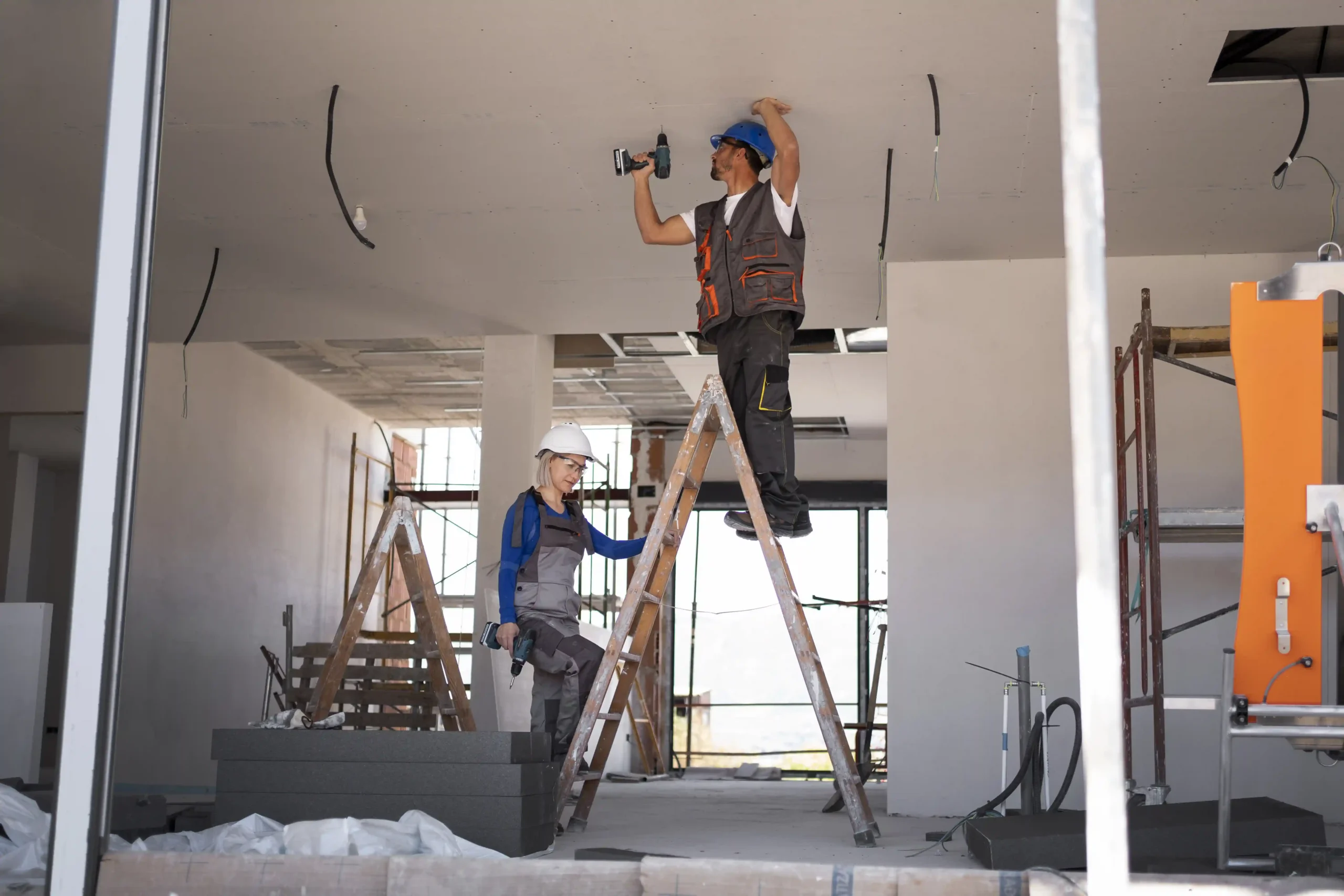The decision to embark on a construction project, whether for residential or commercial purposes, is a significant one that involves careful consideration of various factors.
One of the fundamental choices that stakeholders must make is whether to undertake a renovation of an existing structure or opt for new construction.
Each option has its advantages and disadvantages, and the decision should be based on a thorough analysis of factors such as cost, timeline, sustainability, design flexibility, and long-term value.
In this comprehensive article, we will explore the key differences between renovation and new construction projects, examining the pros and cons of each approach.
By the end, you will have a clearer understanding of the factors that influence this critical decision-making process.
Renovation
Definition of Renovation
Renovation, often referred to as remodeling or refurbishment, involves making significant improvements or alterations to an existing structure while retaining the basic framework and shell of the building.
Renovation projects can range from minor upgrades, such as painting and flooring replacements, to extensive overhauls, which may include structural modifications, electrical and plumbing updates, and interior redesigns.
Advantages of Renovation
1. Cost-Effective
One of the primary advantages of renovation is its cost-effectiveness compared to new construction. Renovating an existing structure typically requires fewer resources and materials than building from scratch. Additionally, renovating a space can often be less time-consuming, which can lead to cost savings on labor and project management.
2. Preservation of Historic or Architectural Value
For buildings with historical or architectural significance, renovation allows for the preservation of these unique features. Many communities value the retention of historic structures, and renovating them can be a way to honor and maintain a piece of local heritage.
3. Faster Project Completion
Renovation projects generally have shorter timelines than new construction. This means that businesses can resume operations more quickly, and homeowners can move back into their renovated homes sooner. The reduced disruption to daily life can be a significant advantage.
4. Environmental Considerations
Renovating an existing building can be a more sustainable option compared to new construction. It reduces the demand for new materials and minimizes the environmental impact associated with demolishing and disposing of an entire structure. Renovation can also provide opportunities to implement energy-efficient upgrades, further reducing the building’s carbon footprint.
Also Read – Magnetic Screen Doors: Keep Bugs Out, Let Fresh Air In
Disadvantages of Renovation
1. Structural Limitations
Older buildings may have structural limitations that restrict the extent of renovation work that can be undertaken. Load-bearing walls and outdated foundation systems can pose challenges, and addressing these issues can be costly and time-consuming.
2. Hidden Costs
During the renovation process, unexpected issues may arise, such as hidden structural damage or the need for extensive electrical and plumbing upgrades. These unforeseen costs can significantly impact on the project’s budget.
3. Design Constraints
Renovation projects are often constrained by the existing layout and structural elements of the building. This can limit design flexibility, making it challenging to achieve a desired aesthetic or layout.
4. Limited Energy Efficiency
Older buildings may not meet modern energy efficiency standards, which can result in higher long-term operational costs. Achieving energy efficiency in a renovation project may require substantial investments in insulation, HVAC systems, and window replacements.
Also Read – Advancements in Sustainable Materials for Infrastructure Construction
New Construction
Definition of New Construction
New construction, as the name suggests, involves building an entirely new structure from the ground up. This approach offers the opportunity to design and customize every aspect of the building according to the specific needs and preferences of the stakeholders.
Advantages of New Construction
1. Design Freedom
Perhaps the most significant advantage of new construction is the unparalleled design freedom it provides. Stakeholders have the opportunity to create a building from scratch, tailoring every detail to their vision. This includes selecting the building’s layout, materials, and architectural style.
2. Modern Infrastructure
New construction allows for the integration of the latest technologies and building systems. This can result in a more efficient and technologically advanced structure, which may lead to long-term cost savings and enhanced comfort.
3. Energy Efficiency
Newly constructed buildings can be designed to meet or exceed current energy efficiency standards. This can result in lower operational costs and reduced environmental impact over the building’s lifespan. Sustainable building practices, such as LEED certification, can also be easily incorporated into new construction.
4. Minimal Hidden Issues
New construction projects are less likely to encounter hidden structural or infrastructure issues, as everything is built from scratch. This reduces the likelihood of unexpected costs and project delays.
Disadvantages of New Construction
1. Higher Initial Costs
New construction projects typically have higher upfront costs compared to renovations. The expense of acquiring land, obtaining permits, and constructing an entirely new building can be substantial.
2. Longer Timelines
Building a new structure from the ground up often takes more time than renovating an existing one. This extended timeline can delay occupancy and revenue generation for commercial projects and may require additional temporary housing for residential projects.
3. Environmental Impact
The construction of a new building can have a significant environmental impact, particularly if it involves the demolition of existing structures. The production and transportation of new materials also contribute to the carbon footprint of new construction projects.
4. Lack of Historic Character
Newly constructed buildings lack the historic character and charm that older structures may possess. In some cases, this absence of history can be a disadvantage, especially in neighborhoods where architectural heritage is valued.
Factors Influencing the Decision
1. Budget
The available budget is often a primary factor in deciding between renovation and new construction. Renovation projects generally require less initial capital, making them a more feasible option for individuals or businesses with limited financial resources. New construction, on the other hand, demands a more substantial upfront investment.
2. Building Condition
The current condition of the building in question plays a crucial role in the decision-making process. If the existing structure is in good shape and only requires cosmetic updates or minor repairs, renovation may be the preferred choice. However, if the building is structurally unsound or does not meet modern safety and code requirements, new construction may be the only viable option.
3. Purpose of the Building
The intended use of the building also affects the decision. For instance, if a business requires a specific layout or functionality that cannot be achieved through renovation, new construction may be the only way to meet those needs. Conversely, for historical preservation or adaptive reuse projects, renovation may be the preferred option.
4. Sustainability Goals
Environmental considerations are increasingly important in construction decisions. If sustainability is a priority, renovation can be a more eco-friendly choice due to its potential for reusing existing materials and reducing waste. New construction, however, provides an opportunity to incorporate the latest green building technologies and achieve higher energy efficiency standards.
5. Timeline
Project timeline is a critical factor, especially for businesses looking to minimize disruption or individuals needing to move into a new home quickly. Renovation projects often have shorter timelines, while new construction projects can take significantly longer to complete.
6. Long-Term Objectives
Consideration of long-term objectives is essential. New construction may offer a better long-term investment for businesses or homeowners who plan to occupy the building for many years, as it provides modern infrastructure and energy efficiency. However, for those interested in preserving historical value or minimizing immediate
costs, renovation may align better with their long-term goals.
Conclusion
The decision between renovation and new construction is a complex one that depends on various factors, including budget, building condition, purpose, sustainability goals, timeline, and long-term objectives. Both approaches have their advantages and disadvantages, and there is no one-size-fits-all answer.
Ultimately, stakeholders must carefully evaluate their specific circumstances and priorities to make an informed decision.
Renovation offers cost-effectiveness, preservation of historic value, and faster project completion, but it may have structural limitations and hidden costs.
New construction provides design freedom, modern infrastructure, energy efficiency, and minimal hidden issues, but it comes with higher initial costs, longer timelines, and a larger environmental impact.
Whichever path is chosen, it is essential to engage with experienced architects, contractors, and project managers who can navigate the complexities of the chosen approach.
By carefully weighing the pros and cons and aligning the decision with individual or organizational goals, stakeholders can embark on a construction project that meets their needs and aspirations.
FAQ’s
Q 1. Is it better to renovate or build a new home?
The decision to renovate or build a new home depends on several factors, including your budget, the condition of the existing structure, your design preferences, and your long-term goals. Renovating an existing home can be cost-effective and environmentally friendly, but it may have limitations in terms of design and structural constraints. Building a new home offers greater design flexibility and modern amenities but often comes with a higher initial cost. Ultimately, the choice depends on your specific needs and priorities.
Q 2. Is it worth renovating an old house?
Renovating an old house can be worth it if you value its historical or architectural significance, location, or sentimental value. Renovation can breathe new life into an old house, improve its functionality, and enhance its market value. However, it’s crucial to conduct a thorough assessment of the building’s condition and budget for potential hidden costs before deciding to renovate an old house.
Q 3. Does renovation cost more?
The cost of renovation versus new construction varies depending on the scope of the project. In general, renovation projects tend to be more cost-effective than building a new structure from scratch. Renovation can often utilize existing building materials and infrastructure, saving on some expenses. However, renovation costs can increase if there are structural issues or extensive upgrades required.
Q 4. What is the difference between updating and renovating?
Updating typically involves making cosmetic or minor changes to a space, such as repainting, changing fixtures, or updating appliances. Renovation, on the other hand, involves more extensive work, such as structural changes, electrical and plumbing upgrades, and changes to the layout or design of a space. Renovation aims to improve the functionality and aesthetics of a space beyond surface-level changes.
Q 5. What are the disadvantages of renovation?
Disadvantages of renovation can include:
- Hidden Costs: Renovation projects may uncover unexpected issues, leading to additional expenses.
- Design Limitations: Renovation projects may have design constraints due to the existing structure’s layout and condition.
- Structural Limitations: Older buildings may have structural limitations that are costly to address.
- Limited Energy Efficiency: Achieving energy efficiency in renovations may require significant investments.
Q 6. When not to renovate a house?
Renovation may not be advisable in the following situations:
- Extensive Structural Issues: If a building has severe structural problems, renovation may not be a practical or safe option.
- Budget Constraints: If your budget is limited, renovating a house with extensive needs may strain your finances.
- Mismatched Expectations: If your renovation goals do not align with the property’s potential or the neighborhood’s market value, it may not be a wise investment.
Q 7. What are the cons of renovating?
The cons of renovating include:
- Cost Overruns: Renovation projects can encounter unexpected costs, leading to budget overruns.
- Timeline Delays: Renovations may take longer than initially planned, causing inconvenience.
- Design Constraints: Existing structures can limit design flexibility.
- Environmental Impact: Renovations may generate waste and have a carbon footprint, especially if energy-efficient upgrades are not prioritized.
Q 8. What is the most expensive part of renovation?
The most expensive aspects of renovation often include structural changes, kitchen and bathroom upgrades, electrical and plumbing work, and high-end finishes. Costs can also escalate when dealing with hidden issues like asbestos or lead paint removal.
Q 9. How much does renovation cost in India?
The cost of renovation in India varies widely depending on factors such as location, scope of work, materials used, and labor costs. As of my last knowledge update in September 2021, a basic renovation in India could start from around ₹1,000 to ₹2,000 per square foot. However, costs can increase substantially for more extensive or high-end renovations. It’s advisable to obtain quotes from contractors and professionals based on your specific project requirements.
Q 10. How can I reduce the cost of renovation?
To reduce the cost of renovation, consider the following strategies:
- Plan Carefully: Create a detailed renovation plan to avoid costly changes and delays.
- Get Multiple Quotes: Obtain quotes from different contractors to compare prices.
- Prioritize Needs Over Wants: Focus on essential renovations and prioritize them over luxury upgrades.
- Reuse and Recycle: Salvage and reuse materials when possible to cut down on costs.
- DIY Where Appropriate: Tackle minor tasks yourself if you have the skills and tools.
- Consider Energy Efficiency: Invest in energy-efficient upgrades to save on long-term operating costs.
Please note that renovation costs can vary significantly depending on location and market conditions, so it’s essential to conduct thorough research and obtain quotes specific to your project.


